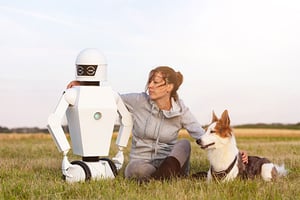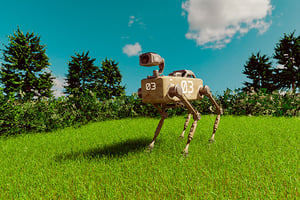
From watching the trailer, it appears that, after Finch builds the robot, it 'grows' like a human, learning how to walk and to drive.
So, just how far from reality is this co-existence and how are robotics batteries paving the way for robots that could fulfil similar functions to Finch's in the future?
Robots walking and driving?
Can a robot really learn to walk or drive as humans do? Advanced humanoid robots can walk along flat or inclined surfaces, climb up and down stairs, and even jump or do backflips. However, according to IEEE Spectrum, ‘despite the progress, legged robots still can’t begin to match the agility, efficiency, and robustness of humans and animals’. Yet, research and development in this area will undoubtedly continue.
And there is no foreseeable sign that we will see a humanoid robot sitting behind the wheel of a car, as Jeff does in Finch. However, we are already seeing delivery robots (that resemble miniature cars) dropping groceries at people’s houses. In the UK, these were allowed to use the pavements in one city in the United Kingdom during the coronavirus lockdown and, in America, authorities are starting to look at changing the laws on the roads to allow delivery robots to operate.
To enable the autonomy of walking and driving robots, battery power is crucial, with many manufacturers opting towards Lithium-ion and Lithium Iron Phosphate chemistries that Accutronics utilise in our bespoke robotics battery packs.
Tomorrow is here today
A primary role of Jeff in the Finch movie is to interact like a human and there are many robots in existence today that aim to fulfil the same need. If you go to a technologically advanced hotel or major sporting event, the chances are that you will run into a customer service robot who will entertain you, assist you and possibly even act as a security guard. Using artificial intelligence, some of these robots can even learn from each other and collaborate on tasks. Similar robots are telepresence robots that have been used in hospitals to act as a video link to connect patients with their relatives or even medical professionals.
Although they fulfil similar functions, customer service robots typically resemble a human shape and have a screen in the stomach area; whereas telepresence robots often resemble a tablet computer on wheels. Therefore, the power demands can vary quite dramatically. At Accutronics, we have supplied Inspired Energy batteries for telepresence robots already on the market but can also design and manufacture custom batteries for next-generation telepresence and customer service robots.

Robot dog walkers or robot dogs?
In addition to interacting like a human, in the Finch film, the robot must also look after the dog. In 2011, it was announced that a robot called Luna was being designed specifically to walk dogs. Also, in 2018, Segway announced that it too was developing a dog walking robot. That turned out to be an April Fool’s joke but, at the rapid rate at which robotics is advancing, how long before it becomes a commercial reality?

Robots are not only man’s best friend, they are man's life saver too
It says a lot about Finch that he is more concerned with the welfare of his dog than his own. However, in the modern world, there are many robots designed to treat seriously ill patients. Just last year, a 31-year-old Harrods salesman received cancer treatment in a hospital in London using a robot controlled by a surgeon in Seattle.
Surgical robots often rely on batteries as a back-up source of power in-case of mains power failure. Lithium Iron Phosphate batteries offer a low weight, long service life, can be mounted in any direction and require no physical maintenance.
As you can see, the lines between Hollywood and reality are becoming increasingly blurred. Although there is not yet one robot who can fulfil all the needs that Finch has, robots are increasingly serving many of the applications that he requires: acting as a companion, delivering groceries, and even saving lives. These applications each have their own unique portable power requirements, so speaking to a battery manufacturer like Accutronics can help to ensure you get the solution you need.